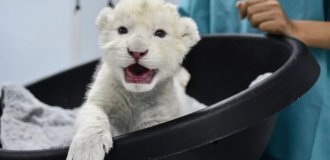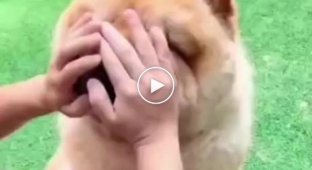Rare Dog Breeds, Ancient and Modern
Bergaman Shepherd (Bergamasco) 
This breed's name comes from the province of Bergamo in Italy. It is an ancient breed of herding dog. They are known for their unique appearance. The Bergamasco's coat consists of three distinct structures that are woven into long, felt-like dreadlocks. These dreadlocks are often flat and can reach a width of 5–7 cm. For centuries, this coat has provided these dogs with excellent protection from all weather conditions and predators. The Bergamasco has a docile and good-natured character. They are intelligent, calm, hardy, and balanced. This shepherd has a weak hunting instinct, so it is generally not aggressive towards other animals, including small ones. Today, the breed remains quite rare and is widespread mainly in Italy. Most dogs of this breed are bred exclusively for working purposes.
Austrian Pinscher 
The Austrian Pinscher is one of the Pinscher breeds. It was developed in Austria as a herding dog and also to guard barns from rats. The history of the Austrian Pinscher spans several centuries. Similar dogs were depicted in paintings from the early 18th century—most likely, "relatives" of the modern Pinscher already existed. However, breeders began purebred breeding in 1921, and the Austrian Pinscher was recognized as a distinct breed in 1928, having been developed from older Pinschers discovered near Austrian farms. These animals were a cross between German-Austrian Pinschers and local dogs. This energetic, active dog is endowed with a rare endurance that few people can boast. An ideal dog for active pastimes, it is attentive, playful, and affectionate by nature. Its hunting instinct is weak, making it an excellent family dog. However, its guarding instinct is well-developed; it protects its family and property, and does not tolerate strangers near it or on its territory. Therefore, Pinschers may bark at strangers seemingly without provocation, and this behavior is often irritating. Currently, these dogs are found in only a few countries, and their numbers are growing slowly.
Leonberger 
The Leonberger is a relatively young German dog breed, created by Heinrich Essing, mayor of Leonberg, in 1846. This breed resembles a lion due to its mane and dark mask. Its friendly nature is inherited from its ancestor, the St. Bernard. Leonbergers are family dogs that enjoy companionship and play. The breed is renowned for its good nature and genuine love for children. From its ancestors, the Leonberger inherited a calm disposition and even a certain phlegmatic nature. It will be very patient with all the pranks of a child and can make a good nanny. Leonbergers are calm with other pets. They can live in the same house with dogs, cats, birds, and rodents, especially if they were raised with them. They are highly intelligent and readily absorb new information.
Bouvier des Ardennes 
The Bouvier des Ardennes is a hardy and lively herding dog from Belgium. It originated around the 18th century and is now considered rare. Although bred primarily as working dogs, Bouviers de l'Ardennes also make attentive, affectionate companions well suited to active families. They are an extremely energetic and inquisitive dog, eager to be constantly on the move, playing, and socializing. They are patient with children and get along relatively well with other pets when properly introduced. Today, the Bouvier de l'Ardennes population is small, with very few found outside of Belgium and France.
Otterhound 
Otterhounds originated in Great Britain, and their popularity is closely linked to the need for otter hunting. The earliest references to this activity date back to the reign of Henry II in the 12th century. The Otterhound's thick, impenetrable coat protects against cold water, which is precisely why it was bred. The Otterhound is a natural hunter. It loves water and is an excellent swimmer; its paws are even webbed. The Otterhound is a large, yet friendly and kind dog; it is sociable, loyal, and full of energy. It loves to play, so it gets along well with children. However, these dogs can be stubborn and independent, and obedience requires lifelong training. Otterhounds strive for dominance, and if they sense weakness in their owner, they will become manipulative. This breed is recommended for people with a strong character. It is important to show the puppy who is boss from an early age.
Dandie Dinmont Terrier 
The Dandie Dinmont Terrier is a small terrier originally from Great Britain, specifically Scotland. It was developed in the 1600s to hunt badgers, otters, and other game. Today, they are most often kept as companions. These dogs are prized for their kindness, cheerful disposition, and sociability. Representatives of this breed are very warm and affectionate with all family members. This dog is people-oriented and requires constant attention and affection. He gets along well with other pets and clearly distinguishes between friends and strangers. While he can sleep peacefully in the same bed with "his" cat, he may perceive "strangers" on the street as prey.
Thai Ridgeback 
The Thai Ridgeback is a dog breed native to Thailand, one of the oldest and rarest breeds. The breed's history dates back to approximately 3,000-4,000 years ago – it is to this period that the first mentions of the breed are found, in ancient drawings from Thailand and Cambodia, depicting similar dogs – presumably the ancestors of the Thai Ridgeback. Representatives of this breed become so attached to their human companion that their prolonged absence becomes a true tragedy. This dog has a highly developed pack instinct. This is why it views its family as a pack. The owner must become a leader for this breed. Only then will the animal obey. Ridgebacks get along well not only with family members but also with other pets. They can safely be left alone with felines, with whom they are willing to share their resting place. Regular exercise is essential for the Ridgeback, so long walks with them should be accompanied by active play. These dogs are good with children and are willing to participate in their active play all day long without tiring. This breed is not considered noisy; they rarely make noise and only when necessary, to warn their owner of danger.
Bedlington Terrier 
Historians believe the first mentions of this breed date back to the 18th century. It originated in what is now Great Britain, on the border between England and Scotland. At that time, this charming, sheep-like dog was known by another name – the Rodbury Terrier – and was bred to hunt small game and rodents. The Bedlington Terrier is an elegant dog, reminiscent of a lamb thanks to its distinctive coat. The Bedlington perfectly combines athleticism and energy with a noble, even-tempered character. This sensitive and understanding dog can become an ideal companion, a pleasant neighbor, and a true life partner. Bedlingtons are very energetic and cheerful and love to be the center of attention. And in return for love, they are willing to become a reliable protector for their owner and family. Playful and energetic, the Bedlington treats children as equals, willing to spend endless time with them and play any game. The Saluki (Persian Greyhound) is one of the oldest dog breeds, renowned for its grace, speed, and hunting ability. According to archaeological excavations and genetic analysis, these graceful hunting dogs originated in the Middle East over 5,000 years ago.
Saluki (Persian Greyhound) 
The Saluki is perfect for those looking for a good companion. This dog chooses its own favorite family member, but gets along well with everyone else. They are gentle, affectionate pets, yet never intrusive in their company or presence. These pets will never disturb their owner while they are relaxing or watching TV; calm and even-tempered character traits are undeniable advantages of this breed.
Mudi 
The Mudi is a Hungarian herding dog breed, with records dating back to the 17th and 18th centuries. These dogs are extremely active, possessing excellent watchdog and guard qualities, and possessing a keen sense of smell. The Mudi is a courageous and hardy dog, very people-oriented. Incredibly obedient, easy to control, and trainable. They sincerely adore and love their owner, who is their main purpose in life, as this is a monogamous breed. They do not tolerate loneliness well. They are very energetic and active, so they require active time, regular walks, and adequate attention. The Mudi is wary of strangers but not aggressive. Gets along with pets, but may chase small pets.
Add your comment
You might be interested in:
























